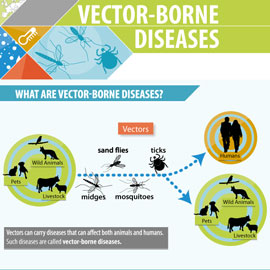Infographic: Vector-borne diseases
- Like
- Digg
- Del
- Tumblr
- VKontakte
- Buffer
- Love This
- Odnoklassniki
- Meneame
- Blogger
- Amazon
- Yahoo Mail
- Gmail
- AOL
- Newsvine
- HackerNews
- Evernote
- MySpace
- Mail.ru
- Viadeo
- Line
- Comments
- Yummly
- SMS
- Viber
- Telegram
- Subscribe
- Skype
- Facebook Messenger
- Kakao
- LiveJournal
- Yammer
- Edgar
- Fintel
- Mix
- Instapaper
- Copy Link
Posted: 30 July 2014 | The European Food Safety Authority | No comments yet
What are vector-borne diseases? What does EFSA do in this field? EFSA’s latest infographic answers these questions and others…


What are vector-borne diseases? What does EFSA do in this field? EFSA’s latest infographic answers these questions and others.
Vectors are living organisms – such as mosquitoes, ticks, flies or fleas – that transmit an infectious pathogen into another living organism, and can spread diseases in humans or animals. Several of the diseases that they transmit are considered emerging infectious diseases- i.e. diseases that appear for the first time, or that may have existed previously but are rapidly increasing in incidence or geographic range.
Travel, global trade, animal movement, climate change and modern agricultural practices are among the factors that contribute to the spread of vectors and the diseases they carry from tropical areas to more temperate zones, such as Europe.
EFSA and the European Centre for Disease Prevention and Control (ECDC) collect data on vectors and vector-borne diseases and analyse their spread in the European Union. Their risk assessments support policy makers to combat the risk to European citizens and animals from these debilitating diseases.






